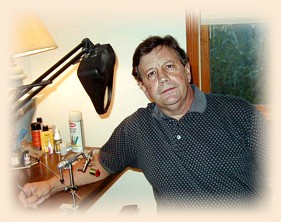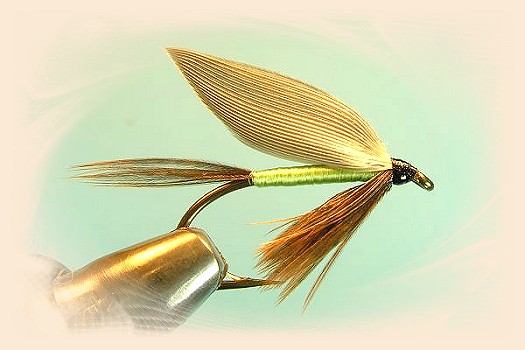I've found another source of old flies, an on-line version
of a book by Bill Blades called Fishing Flies and Fly
Tying. I tied up a few from it this week, and though
there's not much history associated with these, they're all
of interest for other reasons. There are lots of old flies
without available histories, and over the next few weeks I'll
tie some, and give comments or maybe even some tying tips as
we go along.
The first fly is the Apple Green, shown above. I like
this fly for the same reason I like Flight's Fancy, Indian
Yellow, and Mershon White. These flies all exhibit a simple
elegance, demonstrating that a fly doesn't have to be
complicated to be very beautiful.

The next fly, the Admiral, I remember well from the
'60s when I started tying. It's another in the series of
red and white brook trout flies, typified by flies like
The Parmacheene Belle, Lake George, and Scarlet Ibis.
These must have been very important colors in the quest
for native speckled trout back when they were in abundance.
Tail: Scarlet.
Body: Red floss; tag and ribbing, gold tinsel [Bergman
specifies dark red floss, shown here]
Wings: White quill sections.
Hackle: Scarlet.

The Challoner is a fly completely unfamiliar to me,
and one that does not, to my knowledge, appear in any other
book. Bill Blades includes several such flies in Fishing
Flies and Fly Tying, and the book seems to have a
northern slant to it at times. For instance, there is a
section on tying ice-fishing flies. There are also some
Western flies shown as well, giving the book a very different
feel from the largely Eastern-based works of Ray Bergman and
J. Edson Leonard. You will see several flies in this book
that aren't in the standard literature.
Tail: Red Ibis.
Body: Yellow wool; ribbing, gold oval tinsel.
Wings: Hen Pheasant.
Hackle: Natural red.

The Clare Flatt is very close to being a streamer in
many ways. I think it's interesting because he uses "stiff
brown hackle" or cock hackle, rather than the softer hen
hackle used in so many wets. I would guess that this fly
is for faster water.
Butt: Black chenille
Body: Rear two thirds brown floss: ribbing, yellow
tying silk and gold oval tinsel tied on together, front
one third red floss, no ribbing.
Hackle: Stiff brown hackle length of hook.
Shoulder: Jungle Cock.
I've been working hard on the heads of my flies lately, and
I'm hoping it shows. I find that for me, Don Bastian's four-step
process for finishing heads really is superior to other methods
that I've tried. I finally broke down recently and ordered some
Griff's Thick Multi Coat, using it where he uses Hilles, and
have seen quite a difference. I've always used Griff's Thin
Multicoat for the first coat, as Don recommends. This
penetrating glue really cements the head and wing assembly
together. Then he recommends a couple of coats of Hille's
Lacquer Cement, which fills in any small gaps in the thread,
etc. He does a final coat of Pro Lak, a head lacquer he gets
from Canada. I've just been using black lacquer that I bought
at my fly shop, distributed by Wapsi. Whatever you use, coats
of Hille's or Griff's Thick Cement are important, and shouldn't
be skipped. The final black lacquer goes on like a dream then.
I dab all these on with a long straight pin, which works best
for me. So, it's one coat of Griff's Thin, two coats of
Griff's Thick or Hille's, and a coat of black lacquer. This
regimen has helped me a great deal, along with flattening the
thread as you build the head. Give it a try! ~ EA
Credits: Fishing Flies and Fly Tying by
Bill Blades.
About Eric:
 I started fly fishing as a teen in and around my hometown
of Plattsburgh, New York, primarily on the Saranac River.
I started tying flies almost immediately and spent hours
with library books written by Ray Bergman, Art Lee, and
A. J. McClane. Almost from the beginning I liked tying
just as much as I liked fishing and spent considerable
time at the vise creating hideous monstrosities that
somehow caught fish anyway. Then one day I came upon a
group of flies that had been put out at a local drug store
that had been tied by Francis Betters of Wilmington, N.Y.
My life changed that day and so did my flies, dramatically.
Even though I never met Fran back then, I've always
considered him to be one of my biggest influences.
I started fly fishing as a teen in and around my hometown
of Plattsburgh, New York, primarily on the Saranac River.
I started tying flies almost immediately and spent hours
with library books written by Ray Bergman, Art Lee, and
A. J. McClane. Almost from the beginning I liked tying
just as much as I liked fishing and spent considerable
time at the vise creating hideous monstrosities that
somehow caught fish anyway. Then one day I came upon a
group of flies that had been put out at a local drug store
that had been tied by Francis Betters of Wilmington, N.Y.
My life changed that day and so did my flies, dramatically.
Even though I never met Fran back then, I've always
considered him to be one of my biggest influences.
I had a career in music for twenty years or so and didn't
fish much, though I did fish at times. The band I was with
had its fifteen seconds of fame when we were asked to be in
John Mellencamp's movie "Falling From Grace." I am the
keyboard player on the right in the country club scene in
the middle of the movie. Don't blink. It's on HBO all the
time. We got to meet big Hollywood stars and record in John's
studio. It was a blast.
So how did I wind up contributing to the Just Old Flies
column on FAOL? I'm not sure, it was something that I simply
wanted very badly to do, and they let me. Many of the old flies
take me back to the Adirondacs and my youth, and I guess I get
to relive some of it through the column. I've spent many happy
hours fishing and tying over the years, and tying these flies
brings back memories of great days on the water, and intense
hours spent looking at the flies in the fly plates in the old
books and trying to get my flies to look like them. And now,
here I am, still doing that to this day. ~ EA
|





 I started fly fishing as a teen in and around my hometown
of Plattsburgh, New York, primarily on the Saranac River.
I started tying flies almost immediately and spent hours
with library books written by Ray Bergman, Art Lee, and
A. J. McClane. Almost from the beginning I liked tying
just as much as I liked fishing and spent considerable
time at the vise creating hideous monstrosities that
somehow caught fish anyway. Then one day I came upon a
group of flies that had been put out at a local drug store
that had been tied by Francis Betters of Wilmington, N.Y.
My life changed that day and so did my flies, dramatically.
Even though I never met Fran back then, I've always
considered him to be one of my biggest influences.
I started fly fishing as a teen in and around my hometown
of Plattsburgh, New York, primarily on the Saranac River.
I started tying flies almost immediately and spent hours
with library books written by Ray Bergman, Art Lee, and
A. J. McClane. Almost from the beginning I liked tying
just as much as I liked fishing and spent considerable
time at the vise creating hideous monstrosities that
somehow caught fish anyway. Then one day I came upon a
group of flies that had been put out at a local drug store
that had been tied by Francis Betters of Wilmington, N.Y.
My life changed that day and so did my flies, dramatically.
Even though I never met Fran back then, I've always
considered him to be one of my biggest influences.